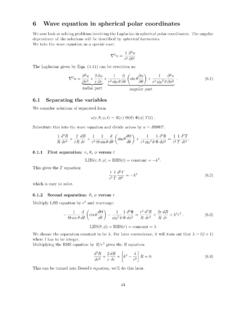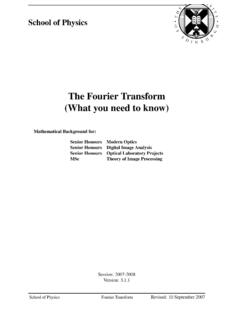Transcription of Lecture 23: Curvilinear Coordinates (RHB 8.10)
1 Lecture 23: Curvilinear Coordinates (RHB )It is often convenient to work with variables other than the Cartesian coordinatesxi( =x,y,z). For example in Lecture 15 we met spherical polar and cylindrical polar are two important examples of what are calledcurvilinear Coordinates . In thislecture we set up a formalism to deal with these rather general coordinate we have effectively covered much of the materical in lectures 18 and 19 where westudied surface and volume integrals. There we considered parameterisation of surfaces andvolumes. Here we do the same thing but think about how this realises non-Cartesian Co-ordinate we change from the Cartesian Coordinates (x1,x2,x3) to the Curvilinear Coordinates ,which we denoteui, each of which are functions of thexi:-u1=u1(x1, x2, x3)u2=u2(x1, x2, x3)u3=u3(x1, x2, x3)Theuishould be single-valued, except possibly at certain points, so the reverse transforma-tion,xi=xi(u1, u2, u3)can be made.
2 A point may be referred to by its Cartesian coordinatesxi, or by its curvilinearcoordinatesui. For example, in 2-D, we might have:-Now considercoordinate surfacesdefined by keeping one coordinate constant. The Cartesian coordinate surfaces xi= constant areplanes, withconstantunitnormal vectorsei(ore1,e2ande3), intersecting at right angles. The surfaces ui= constant donot, in general, have constant unit normal vectors,nor in general do they intersect at right :Spherical polar co-ordinatesr= x2+y2+z2; = cos 1{z x2+y2+z2}; = tan 1(yx).The surfaces of constantr, , and are:-r= constant = spheres centred at the origin unit normaler = constant = cones of semi-angle and axis along thez-axis unit normale = constant = planes passing through thez-axis unit normale These surfaces arenotall planes, but theydointersect at right the coordinate surfaces intersect at right angles ( the unit normals intersect at rightangles), as in the example of spherical polars, the Curvilinear Coordinates are said to 1.
3 Orthogonal Curvilinear CoordinatesUnit Vectors and Scale FactorsSuppose the pointPhas positionr=r(u1,u2,u3). If we changeu1by a small amount,du1,thenrmoves to position (r+dr), wheredr= r u1du1 h1e1du1where we have defined theunit vectore1and thescale factorh1byh1= r u1 ande1=1h1 r u1. The vectore1is a unit vector in thedirection of increasingu1. The scale factorh1gives themagnitudeofdrwhen we make the changeu1 u1+ for an infinitessimal change ofu1|dr|=h1du190 Similarly, we can definehiandeifori= 2 and 3. The unit vectorseiarenot constant vectors. In general they arenon-Cartesianbasis vectors, they depend on the position vectorr, change as theuiare varied.
4 Ifei ej= ij, then theuiareorthogonal Curvilinear Cartesian Coordinates , the scale factors are unity and the unit vectorseireduce to theCartesian basis vectors we have used throughout the course:r=xe1+y e2+z e3so thath1e1= r x=e1, : spherical polars:u1=r,u2= andu3= in that order:r=rsin cos i+rsin sin j+rcos k,where to avoid confusion in this section we usei,j,kfor theCartesianbasis vectors. (Bythis stage there should be no confusion with the sufficesi,j,k). Therefore r r= sin cos i+ sin sin j+ cos k= hr= 1 r =rcos cos i+rcos sin j rsin k= h =r r = rsin sin i+rsin cos j= h =rsin Thuser= sin cos i+ sin sin j+ cos k=r/re = cos cos i+ cos sin j sin ke = sin i+ cos jThese unit vectors are normal to the level surfaces described above (spheres, cones andplanes) and are clearly orthogonal:er e =er e =e e = 0and form a RH orthonormal basis:er e =e ,e e =er,e er=e.
5 Example: Cylindrical polars:u1= ,u2= andu3=zin that order:r= cos i+ sin j+z r = cos i+ sin j; r = sin i+ cos j; r z=kandh = 1 ;h = ;hz= 1 Thereforee = cos i+ sin j;e = sin i+ cos j;ez=k91 These unit vectors are normal to the level surfaces described by cylinders about thez-axis( = constant), planes through thez-axis ( = constant), planes perpendicular to thezaxis(z= constant) and are clearly : An example of a Curvilinear coordinate system which isnotorthogonal is providedby the system of elliptical cylindrical Coordinates (see tutuorial ).r=a cos i+b sin j+z k(a6=b)In the following we shall only consider orthogonal systemsArc LengthThe arc lengthdsis the length of the infinitesimal vectordr.
6 -(ds)2=dr Cartesian Coordinates (ds)2= (dx)2+ (dy)2+ (dz) Curvilinear Coordinates , if we change all three coordinatesuiby infinitesimal amountsdui, then we havedr= r u1du1+ r u2du2+ r u3du3=h1du1e1+h2du2e2+h3du3e3 For the case of orthogonal curvilinears, because the basis vectors are orthonormal we have(ds)2=h21du21+h22du22+h23du23 For spherical polars, we showed thathr= 1, h =r,andh =rsin therefore(ds)2= (dr)2+r2(d )2+r2sin2 (d )292 Lecture 23 continued:23. 2. Elements of Area and VolumeBasically we just repeat using scale factors what we did in lectures 18 and AreaIfu1 u1+du1, thenr r+dr1, wheredr1=h1e1du1, and ifu2 u2+du2, thenr r+dr2, wheredr2=h2e2du2.
7 (Curvature greatly exaggerated in figure!)On the surface of constantu1thevector areabounded bydr2anddr3is given bydS1= (dr2) (dr3) = (h2du2e2) (h3du3e3) =h2h3du2du3e1,sincee2 e3=e1for orthogonal a vector pointing in the direction of thenormalto the surfaces u1=constant ,its magnitude being the area of the small parallelogram with edgesdr2anddr3. Similarly,one can the case ofspherical polars, if we vary and , keepingrfixed, thendSr=(h d e ) (h d e )=h h d d er=r2sin d d fordS anddS .VolumeThe volume contained in the parallelepiped with edgesdr1,dr2anddr3, isdV=dr1 dr2 dr3= (h1du1e1) (h2du2e2) (h3du3e3)=h1h2h3du1du2du3becausee1 e2 e3= polars, we havedV=hrh h dr d d =r2sin dr d d 93 Components of a Vector Field in Curvilinear CoordinatesA vector fieldA(r) can be expressed in terms ofcurvilinear componentsAi, defined as.
8 A(r) = iAi(u1,u2,u3)eiwhereeiis theith basis vector for the Curvilinear coordinate Coordinates , the componentAiis obtained by taking the scalarproduct ofAwith theith ( Curvilinear ) basis vectoreiAi=ei A(r)NBAimust be expressed in terms ofui(notx,y,z) when working in Cartesian Coordinates , then in spherical polars,Ar=A er= sin cos , (r, , ) = sin cos er+ cos cos e sin e .ExampleIfA=rthen in cylindrical polarsA =A e = cos2 + sin2 = etc, andA( , ,z) =r= e +z ez23. 3. Grad, Div, Curl, and the Laplacian in Orthogonal CurvilinearsWe defined the vector operators grad, div, curl firstly in Cartesian Coordinates , then mostgenerally through integral definitions without regard to a coordinate system.
9 Here we com-plete the picture by providing the definitions in any orthogonal Curvilinear coordinate section (2) we defined the gradient in terms of the change in a scalar fieldfwhen we letr r+dr f= f(r) dr(1)Now consider what happens when we writefin terms of orthogonal Curvilinear coordinatesf=f(u1, u2, u3). As before, we denote the Curvilinear basis vectors bye1,e2, u1+du1,u2 u2+du2, andu3 u3+ Taylor s theorem, we have f= f u1du1+ f u2du2+ f u3du3We have already shown thatdr=h1du1e1+h2du2e2+ the orthogonality of the basis vectors,ei ej= ij, we can write f=( f u1e1+ f u2e2+ f u3e3) (e1du1+e2du2+e3du3)=(1h1 f u1e1+1h2 f u2e2+1h3 f u3e3) (h1e1du1+h2e2du2+h3e3du3)=(1h1 f u1e1+1h2 f u2e2+1h3 f u3e3) drComparing this result with equation (1)
10 Above, we obtain the following expression for fin orthogonal curvilinears f=1h1 f u1e1+1h2 f u2e2+1h3 f u3e3=3 i=11hi f uieiForspherical polars, we obtain f(r, , ) =er f r+e 1r f +e 1rsin f .Forcylindrical polars, we obtain f( , ,z) =e f +e 1 f +ez f orthogonal Curvilinear coordinatesdivA=1h1h2h3{ u1(A1h2h3) + u2(A2h3h1) + u3(A3h1h2)}This expression can be obtained by using the integral definition of divA, or alternativelyusing vector operator identities (see BK , RHB ).For Cartesian Coordinates , we havehi= 1, and we regain the usual expression for polarswe havedivA(r, , ) =1r2sin { r(r2sin Ar)+ (rsin A )+ (rA )}=1r2 r(r2Ar)+1rsin { (sin A )+ (A )}.








